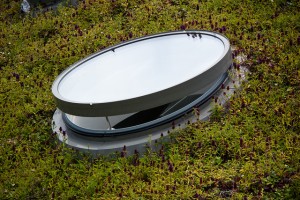Living, Growing Roofs Beginning to Sprout in Aotearoa
Aucklander Robyn Simcock is renovating her garage. As is, it is slightly sunken into the ground so that the roof is only a metre above the pavement. She has pumice, wild flowers, succulents and New Zealand natives ready for the renovation. She wants the garage to look nice, because it can be seen from the street. However, these plants and rocks aren’t for landscaping the garden around it. They are part of the renovation. Ms Simcock is creating a living, growing, roof. Robyn Simcock, who works at Land Care Research New Zealand, has one of the first living roofs in New Zealand.
Her green roof, as it’s called, is made up of a mixture of media. It has a base layer which provides the solid roof, a soil layer, and a ‘mat’ of plants –mainly sedums, which are mosses.
“I had to make sure the Auckland City Council understood exactly what I meant,” she says of the process involved in getting resource consent to build her green roof. At first they thought it was landscaping, she says, but after a few hard line phone calls, she managed to tick all necessary boxes and got permission to build one on her suburban home.
Her experience of having the green roof installed led her to join University of Auckland researcher Dr Elizabeth Fassman and Auckland Regional Council in a joint project looking into the potential uses and application of green roofs in New Zealand. After a four year study, involving a roof being installed on top of the engineering department at the University of Auckland, their research is almost complete. Amid the droughts and torrential rain Auckland experiences, the research has proven that green roofs can effectively reduce storm water runoff by up to 75 percent. It also has the potential to reduce the urban heat island created by concrete roofs in the city.
The initial focus for the project was to find New Zealand plants that could potentially be used for green roofs on commercial buildings. However, along the way they discovered more interest in residential roofs with aesthetic value and the potential for growing vege gardens.
“At first it doesn’t look nice,” says Dr Fassman.
But their use is catching on, and they are becoming more and more popular. However, the roofs are still expensive to use, and according to the researchers of green roofs, there is a public perception that they could be leaky. Dr Fassman and Ms Simcock all agree, in order for the technology to be successfully used in New Zealand there now needs to be policy towards their use, adapted at a government level.
Haydon Easton, the storm water advisor from Auckland Regional Council, who also helped out with research, says policy is still a long way off.
“It’s a growing industry that’s still in its infancy,” he says. Mr Easton’s view is that education about the roofs needs to come next, before anything else progresses.
Many local councils do have guidelines for people and businesses wanting to install a green roof. North Shore City Council has incentives for use, and Waitakere City Council currently has a green roof. But it is unsure what will happen once the council changes in November. Deputy Mayor of Waitakere City Council, Penny Hulse, says that although there are current guidelines for green roofs in place, they may be lost among the transition to a super city council.
“My concern at the moment is that no one has bothered to talk about sustainability for the super city.”
Ms Hulse believes that green roofs are an example of new technology that could benefit the city overall, but is one of many sustainability issues that is being forgotten amid the confusing transition to become Auckland Council. Local government policy analyst Larry Mitchell also agrees.
“It’s one of the many question marks surrounding the super city. How strongly will advocacy for air, soil and water issues be?” says Mr Mitchell.
He believes the answer lies in how Auckland Regional Council, which deals with environmental issues, is “folded into the new super city”.
Lucky for Robyn Simcock, the outcome of the elections won’t affect her bid to get a green roof. Says Simcock:
“At first you’ve got to get the technical standards up to scratch, demonstrate that the roofs can be affectively used, and then you have to demand that they’re used.
“You just have to do it,” she says, likening the process to that of changing the earthquake regulations and standards for buildings.
loading...
loading...
Tags: green design, green roofs




Great article Hannah :). Cool to see that green roofs are taking off in NZ. such a good way to develop urban spaces.
loading...
loading...
Sounds good, Anywhere where we can see more pictures ? Thanks
loading...
loading...
more info about green roofs can be found at
http://www.livingroofs.org.nz
http://www.greenroofs.co.nz
hope that helps =)
loading...
loading...